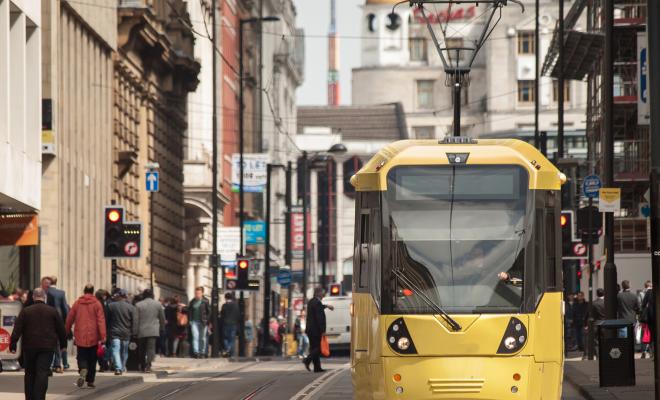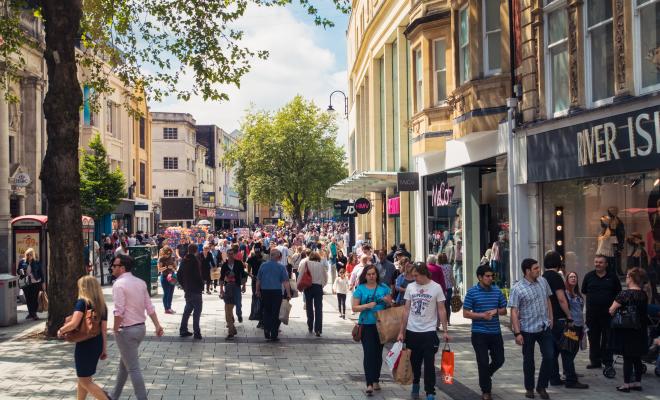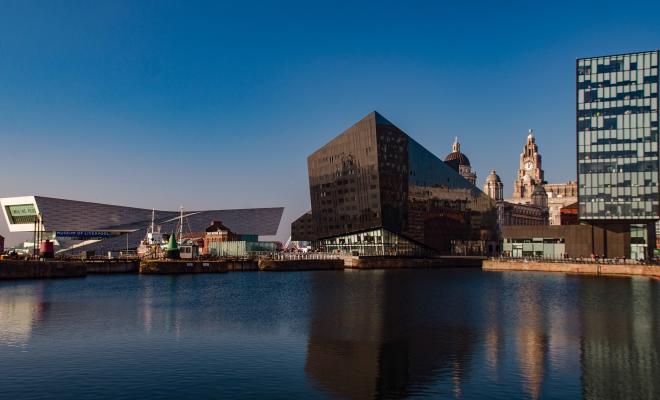26 Apr 2024
How is Action 3 tackling the climate crisis?
Some of the actions required to tackle climate change locally will involve people making changes to their lives, and some will be controversial. Councils need to engage residents and address their concerns if they're to successfully introduce the measures that are needed.
London Borough of Waltham Forest’s "Enjoy Waltham Forest" initiative features a wide range of measures aiming to boost walking and cycling in the area. The programme, which launched in 2014, intends to make Waltham Forest a better place to live by creating health, social and economic benefits for local people.
However, many aspects of the initiative, such as the pedestrianisation of high streets and the use of blended crossings that are designed to slow traffic and emphasise pedestrian priority, have proved contentious among residents. In order to better understand public opinion and take decisions that reflect the needs of local people, the council carried out an extensive engagement and consultation process. This invited residents to:
- Take part in an initial perception survey
- Feedback on concept designs
- Take part in workshops with the authority
- Give their views on preliminary designs
- Take part in a full public consultation
- Feedback on detailed designs
- Input into a statutory process
- Take part in a final review.
The perception survey asked residents how they viewed their local area, and what new travel, safety and public realm improvements they'd like to see introduced. The results showed demand to boost the attractiveness of the local area and highlighted places with the highest amounts of resident feedback, overlapped with areas with the highest traffic levels.
Following this, the council produced a detailed report mapping out resident concerns and aspirations. This formed the basis for the initial concept design process.
Later, multiple in-person workshops and drop-in sessions gave people the chance to have practical discussions with the council. The in-person, participatory decision-making process centred on key exercises that were informative, inclusive and interactive.
First, residents mapped out where they walked and cycled. Next, residents were able to review an initial concept design and highlighted the changes they wanted. This allowed them to comment on key aspects of the plan such as modal filters, crossing points, traffic calming measures and improving streets for pedestrians and cyclists.
The third exercise allowed attendees to comment on improvements they'd like to see in public spaces. Feedback here included the introduction of more trees, street art and small green spaces as well as improved lighting on busier streets. The council also carried out meetings with important stakeholders such as local residents’ associations and the emergency services.
The authority used the feedback from the perception survey and subsequent engagement workshops, as well as local traffic data, to produce a new preliminary design for active travel measures. These were subject to further public consultation, with 4,600 consultation documents handed to houses in the immediate areas where travel would be impacted.
The council knocked on the doors of 90% of homes targeted by the consultation to encourage a high volume of feedback and responses from diverse groups. The final feedback offered at this stage fed directly into the detailed design phase of the process.
Under the council’s new Air Quality Action Plan, published in 2023, more low traffic neighbourhoods are planned up to 2028, pending a government review of guidance around low traffic neighbourhoods announced in 2023.
What impact has the project had?
Involving local people resulted in direct changes to project design and delivery. This included:
- Responding to strong support for road closures at some sites, including Aubrey Road, where 84% of locals were in favour of action.
- Taking out other modal filters, including at Rectory Road, where 59% were against it.
This participatory approach meant that the council was able to implement well-received measures that are less likely to be overturned in the future. Introducing powerful measures in harmony with local opinion has led to significant environmental impacts.
A King’s College London report found that new road layouts and segregated cycle lanes in Waltham Forest had reduced exposure to 2 health-damaging pollutants, nitrogen dioxide and PM2.5, by 15-25% and 6-13% respectively between 2013 and 2020. A University of Westminster study showed that these active travel policies mean that on average Waltham Forest residents are walking for 32 more minutes a week and cycling for an extra 9 minutes.
A 2020 study found that Waltham Forest’s measures had no discernable negative effect on fire service emergency response times, which is a concern that’s sometimes raised about traffic control measures.
The impacts for health and safety saw Waltham Forest score the highest of any outer London borough in the 2023 Healthy Streets scorecard, which ranks authorities based on 10 different indicators.
The success of “Enjoy Waltham Forest” has made the council a national exemplar. It hosts frequent study tours, which have seen councils from as far afield as Glasgow, and even international visitors, come to learn and observe. In 2024 “Enjoy Waltham Forest” celebrates its 10-year anniversary, and the council intends to continue supporting other local authorities that have received funding for “Mini-Hollands” projects (which aim to make London boroughs as cycle friendly as their Dutch equivalents and is part of the Mayor’s Healthy Streets approach) by hosting more learning events such as conferences.
What made this work?
The council made its engagement with the public a genuine conversation.
It emphasised community-wide benefits of taking action, such as reduced pollution, improvements to children’s health and safer travel.
The first stage of the project was a pilot held over 3 weeks in September 2014, a first for the UK on such a scale. The proposals were introduced temporarily and embellished by local residents’ suggestions from a traffic management scheme already underway in the area.
The pilot was a live consultation document enabling people to observe the proposed permanent changes and experience how their area could feel if non-local traffic was removed and how their day-to-day lives would change. Given the drastic nature of the proposal, like using modal filters (physical structures that allow the passage of some modes of transport but not others) to remove the ability to travel north-south or east-west through a popular residential area with a thriving local high street, there was a risk it wouldn't be supported through a traditional transport consultation approach.
Surplus temporary highway materials were used to introduce 8 modal filters at strategic locations preventing east-west and north-south movements through the area by motor vehicle. Variable message signs and traditional traffic management signage were used to deter non-local vehicles attempting to travel through the area.
In places no longer dominated by traffic, temporary parklets were constructed with seating, cycle parking including "car bike ports," and planters of trees. The use of temporary materials enabled the council to react to requests and concerns from residents, including reducing the width of some modal filters and even adding an additional modal filter. It used diagrams and infographics to clearly demonstrate these benefits, making the scheme feel real and encouraging residents to buy into the new vision for the area.
The council delivered on its promises, as the extra space created by modal filters was used to deliver public realm benefits that were asked for during the public surveying stage.
However, it was also important to be honest with locals about the negatives that may arise, such as longer car journeys to get out of an area with new traffic measures, the length of time construction workers would be carrying out work on residents’ streets, and the congestion this would cause. This honesty was critical to easing friction that may arise with residents as measures are implemented.
Flexibility and autonomy for the officers working most closely on the project meant more responsiveness and a greater ability to listen to residents and make corresponding changes.
“The cabinet agreed to a strong governance and project management approach, approving each scheme in principle and giving officers the power to make day-to-day decisions.”
Vala Valavan, former Director of Highways and Traffic Management at Waltham Forest Council
What resources were needed?
The "Enjoy Waltham Forest" programme has been delivered via the Highways and Traffic Management Department. A dedicated "Enjoy Waltham Forest" team was set up in 2014 and comprised of engineers, project managers, technicians, and engagement and consultation specialists, alongside staff supporting delivery from the wider department, which provided a holistic approach to scheme design and delivery.
Funding was primarily from Transport for London’s (TfL) "Mini-Hollands" budget, with Waltham Forest allocated £27 million to deliver the programme. This was complemented by aligning further funding from TfL’s Local Implementation Plan (LIP), cycle parking, Liveable Neighbourhoods and bus priority programmes. Collectively, approximately £40 million has been spent on walking and cycling improvements in Waltham Forest to date.
Over time, creative funding solutions have been devised so as not to be reliant on funding from TfL alone. The council has been working closely with developers to raise funds via the Community Infrastructure Levy. The council has also been able to bring in funding from new sources by integrating other key policy objectives. For instance, incorporating rain gardens and other flood mitigation measures into its active travel initiatives has enabled funds to be secured from Thames Water.
Lessons from Waltham Forest
Actively engage the local community
Councils considering similar action should commit to incorporating people’s voices into final design plans. This is important in ensuring the long-term sustainability of the decisions they're trying to make, while also serving to build trust with the local community taking part in public decision-making processes.
Waltham Forest’s tips when consulting the public are that councils shouldn't set out binary "yes or no" votes. Sliding scales of approval should be used to provide residents with the opportunity to voice a preference without the consultation developing into a perceived referendum. It can also prevent turning mild concerns into definitive opposition.
Councils should also consider the timing of both their consultation and implementation. Installing low traffic measures in autumn/ winter when people are naturally spending less time outdoors and more time in their cars could result in a less enthusiastic reception, as residents may not be fully able to appreciate the benefits of reduced traffic.
Political will is essential when incorporating public voices into key decision making. Officers and councillors must understand the project and sincerely support it to ensure that concerns of locals can be discussed and solved through consultation, without giving in to critical voices as they arise.
Waltham Forest found that engaging local stakeholders, such as MPs, religious leaders, GPs and schools, before reaching out to the wider public was important. This can ease any hesitations that residents may have about both being involved in public consultation and the project itself, by seeing that trusted local people and institutions are already involved.
Waltham Forest will continue to implement its active approach to engagement with public concerns. Plans for 2 new schemes at Lloyd Park and Blackhorse Lane in 2024 received more positive than negative feedback. In line with the council’s commitment to co-design, the plans have already been amended at residents’ request, reducing the number of modal filters proposed (to restrict vehicles) from 9 to 5.
“When they are done well, these schemes are pro-people, not anti-car. They’ve been around for longer than many of the most pro-motorist commentators let on, and in Waltham Forest they’ve proven to be a roaring success.”
Councillor Clyde Loakes, Deputy Leader of Waltham Forest Council
Counter opposition with practical alternatives
Low traffic neighbourhoods and other similar policies have increasingly received political and media attention, which has prompted greater awareness but also some negative responses. Waltham Forest has used this as an opportunity to encourage residents to make behavioural and lifestyle changes. For example, when the London Ultra Low Emission Zone (ULEZ) was expanded to include the northern part of Waltham Forest, the council shared resources to help people switch to an electric car, and it’s committed to installing more chargepoints. It also began working with car club operators to introduce more shared vehicles in the north of the borough as an alternative option for those facing the ULEZ charge.
When signposting these alternatives, a mixed engagement approach helps reach more people. While the council has shared resources and information through its own social media platforms, it’s also used community groups to spread the word. The council’s Community Walking and Cycling Fund awards grants to support local organisations to run their own active travel projects. Through these groups, the council can reach residents who wouldn’t normally engage with anything council-branded but who will likely respond more positively to messages and activities run by fellow neighbours.
Friends of the Earth's view
Council decisions on how to reduce carbon emissions won't always be popular with everyone. Waltham Forest has shown that genuine engagement with affected communities and making decisions together helps to overcome objections. Councils will need to allocate sufficient staff and resources to set up a genuinely participatory process. It’s important for councils to learn from each other, so it’s great that Waltham Forest is sharing its considerable experience of how to boost walking and cycling with community support.
Councils should also improve how to involve citizens in wider decision-making processes (Action 6 of the Climate Action Plan).
Friends of the Earth is showcasing specific examples of good practice in tackling climate change, but that doesn’t mean we endorse everything that a council is doing.
This case study was produced by Ashden and Friends of the Earth. It was originally published in February 2022 and was last updated in April 2024.






